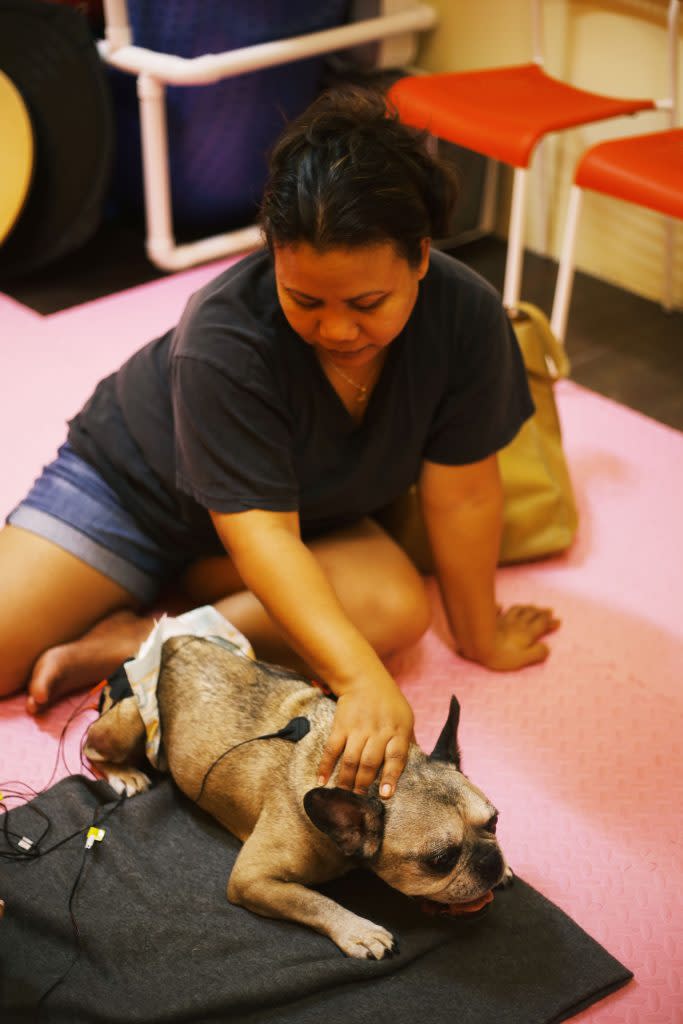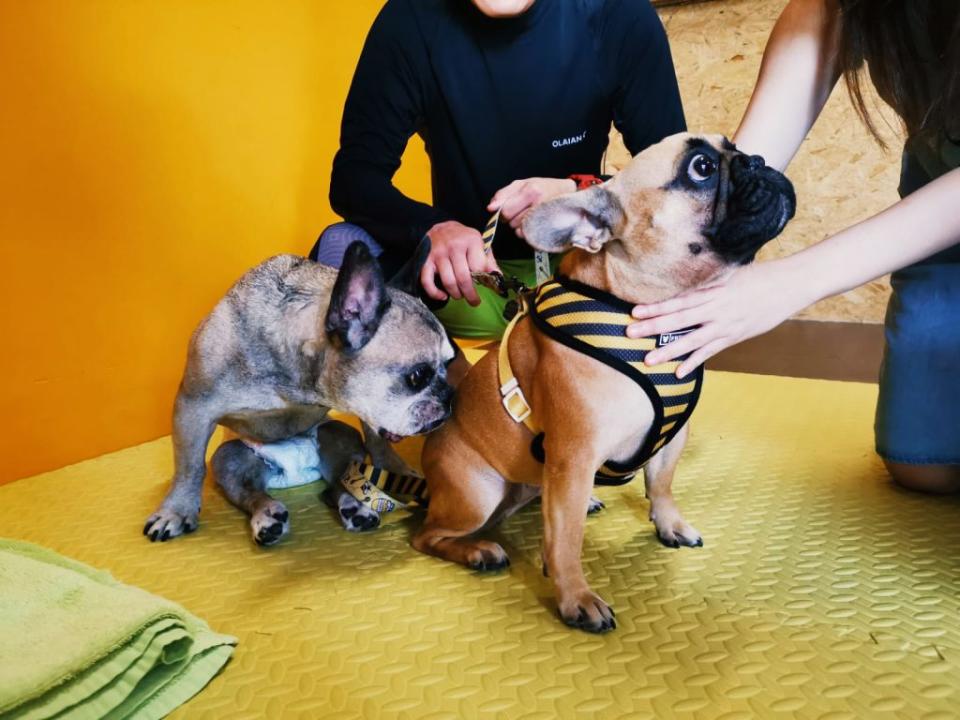Your Pet Can’t Tell You When They’re In Pain. This Vet Wants To Help.
All photographs by Marisse Caine unless otherwise stated.
A Pembroke Welsh corgi with the gorgeous locks of Jonathan Van Ness. A silky terrier nestling contentedly in her owner’s arms. A French bulldog with a Cheshire grin, tongue lolling out, saliva drooling sloppily.
I should have been in paradise. Instead—
The corgi’s eyes are milky with cataracts. The silky terrier is blind even though her eyes are clear and searching. The French bulldog tries to approach me: he struggles to pull himself forward but his back legs are splayed lamely behind him.
He’s still smiling. I’m smiling too, in what I hope is a sign of encouragement, but inside, I feel like my heart has dissolved to a puddle of tears.
Thankfully, at that moment, Dr Sara Lam emerges to rescue me from a potentially embarrassing moment.

Dr Sara, “a girl’s age is a secret”, is the owner of RA Healing Centre. She is the first veterinarian in Singapore to be certified in animal rehabilitation.
Her motivation to specialise in the field was triggered by her frustration that the standard response to pain was a barrage of painkillers. While their analgesic properties are efficient, these medications only treat the symptoms of pain without addressing its source.
Therefore, unlike traditional animal clinics, RA Healing Centre focuses on animal rehabilitation. In other words, physical therapy to help afflicted animals manage their pain.
Think of it as the difference between a psychiatrist and a therapist: the former prescribes medication to modify the chemical composition of your brain, while the latter targets your thought processes to alter your mood.
Hence, Dr Sara emphasises, her centre does not claim to “treat any acute diseases”. Instead, she helps animals to “maintain and manage” their life even in the face of debilitating illnesses like cancer or vestibular disease.
The facilities in her centre reflect its focus on physical therapy. There is a heated hydrotherapy pool, an electroacupuncture machine, a stance analyser (“the only one in Singapore”, Dr Sara says proudly), a hyperbaric chamber (of the sort Michael Jackson used to sleep in), and a myriad array of devices designed to improve the well-being of animals—all of which are adopted from human physiotherapy principles.
Whatever the treatment, Dr Sara volunteers as tribute first, as far as possible. She recounts to me the events behind her purchase of a cold laser machine, which purportedly uses light “to change body metabolism at a molecular level so the cell can recover better”.
“It just happened that I fell down [on the day I was meeting the sales representative]. My bone was hurting, so I asked the sales representative, ‘can I use the laser machine or not?’ Immediately the pain went away. So then, I said, ‘ok, I’ll buy.’”
None of the treatments at RA Healing Centre are invasive or painful—it would, after all, be antithetical to a centre whose “main goal is to relieve pain”.
“They have a really good life here, the dogs,” Dr Sara muses, “Sometimes they fall asleep in the warm pool or on the acupuncture chair. They get a 6-hands massage that feels like those OSIM ones.”
I express my envy and tell her I wish I could experience these procedures too. Dr Sara laughs and points to a corner of her centre where exercise balls are stacked.
“When the animals get stronger, it becomes a gym, we work them really hard. It’s not like a spa anymore when they get better.”
Hearing that, I cheer up immensely. It’s not my sense of schadenfreude, but the suggestion that some animals do “get better”, whether it’s by learning how to walk again or something as simple as sitting upright.
Before I let my sadness abate entirely, however, I decide to talk to the clients themselves so as to corroborate Dr Sara’s account.
I approach Rosco and ask if he is willing to be interviewed.
He barks in assent.

Rosco is a 14-year-old French Bulldog.
When he was 6, he was diagnosed with a slipped disc in his lower back; Dr Sara explains that any surgery for the spinal cord should be conducted within a “golden period”. Unfortunately, Rosco’s owners missed that window, so any surgical intervention now would have more risks than potential benefits. Therefore, Rosco has been managing his lower-back pain with physiotherapy for the last 8 years.
“Without this treatment, it’s going to get worse. Or you may not even see him now,” Dr Sara says.
Lorena, the domestic helper of Rosco’s owners, concurs.
“Last last week, before we started acupuncture again, Rosco was so weak. You don’t know what happened to him. He cannot breathe properly. It’s so sad. Last week, he did the hyperbaric treatment. It’s helping a lot. Rosco wasn’t barking before. Now it’s like rarrhgghhrh,” Lorena growls, and Rosco looks at her quizzically.
When asked why Rosco ceased his treatment at RA Healing Centre temporarily, Lorena says that the family is relocating to the United States soon.
“Actually, we’re trying to stop the acupuncture and everything for Rosco. But Rosco, he wants to come back.”
Rosco nods. Or so I imagine.
“He’s here so often,” Lorena says, “Actually this is like his second family. This is his second home.”

Lorena’s words perfectly capture the scene in front of me.
Dr Sara is massaging Rosco’s shoulder and chest. He’s sitting on her lap, drooling contentedly, a silly smile plastered on his face. Sean and Preetijit, Dr Sara’s assistants, are sitting in a circle around Rosco, each making sure Rosco feels no discomfort during his electrotherapy.
In between Rosco’s treatments, Dr Sara asks Lorena about her week. Lorena says her employers just hosted a party in which “most guests went home without their shoes”. Lorena then shows Dr Sara a photograph of Rosco in a captain’s outfit, taken at said barefoot party.
It reminds Dr Sara of another photograph of Rosco.
“Rosco has a girlfriend! A one-year French Bulldog!”
“They met at a massage place,” Lorena chuckles as she shows me the photograph of the two infatuated dogs, “She’s like, ‘please don’t lick me’—“
“—and he’s like ‘I want you’,” Dr Sara completes.

From their interactions, I sense that this is not just Rosco’s second family, but Lorena’s too. Her relationship with Dr Sara has evolved from client-practitioner into a genuine friendship, forged by their mutual love for Rosco.
In fact, when I am here, I feel like I am intruding on a gathering of several close friends, eavesdropping on their easy conversation.
Then, there is a sudden commotion. There are cries of despair, frantic scrambling for tissue paper, lunges for the disinfectant.
“Oh no wonder! You poo the bomb!” Lorena exclaims affectionately.
The ‘bomb’ in question is an exquisite, perfectly pyramidal pile of poo issuing from Rosco just as Preetijit is inserting a thermometer into his rectum.
Amidst this apoocalypse, Dr Sara is sitting serenely, a beatific angel in red still kneading the knots out of Rosco’s shoulders.
“Sorry Ms Sara!” cries Lorena.
“It’s okay,” Dr Sara murmurs, unperturbed.
“You’re lucky Ms Sara loves you. Yes, you’re lucky,” Lorena tells Rosco.

Animals can’t speak. They can whine, cry, and whimper, but can’t tell you directly that they’re in pain.
Sometimes, according to Dr Sara, animals are so non-vocal they choose to lie down in silence and bear with, instead of expressing their pain. Their owners think that they are just lazing around more than usual, blind to their pets’ suffering.
I want to say that Dr Sara is giving a voice to these animals. Not just the ones who bear their pain stoically, but also those who have to perform pain in order to draw our attention to their suffering.
Pain, however, is notoriously private and inexpressible. “Let a sufferer try to describe a pain”, Virginia Woolf writes, “and language at once runs dry”.
If it’s difficult for us to think and speak about pain, what, then, of animals? Is their agony worse than ours because they cannot understand why they’re in pain? Is their pain more intense because they lack the means to communicate and share it?
To paraphrase the philosopher Thomas Nagel, who was interested in the problem of consciousness: “In so far as we can imagine the pain of an animal (which is not very far), it tells us only what it would be like for us to feel as an animal feels—not what it is like for an animal to feel pain as an animal.”
In other words, we are always confined by the parameters of our own minds. When we try to put ourselves in the paws of a dog, we inevitably fail. We can never understand what it is like for Rosco, the doggiest of dogs, to feel that excruciating spasm of pain up his hind legs.

Any attempt to valorise Dr Sara’s physiotherapy work as the panacea for pain, then, is ultimately facile.
Still, that is not to say that her practice is futile.
On the contrary, sitting in on her consultation has been one of the most moving, and emotionally draining, experiences I have had.
“We’re doing something for the animal,” Dr Sara says. “Even though it doesn’t seem a lot. Even if it’s just doing some exercises and talking to the owner, it helps a lot as well. They come here and it’s like, ‘there are still people who support us. I’m going to keep going.’ It’s actually quite motivating for me to see pet owners so committed.’”
“That’s how we’re different from a normal vet clinic.”
Bark bark woof arf bark meow? community@ricemedia.co
The post Your Pet Can’t Tell You When They’re In Pain. This Vet Wants To Help. appeared first on RICE.



